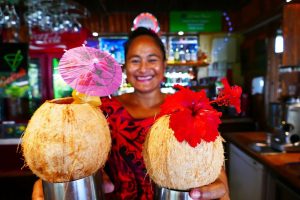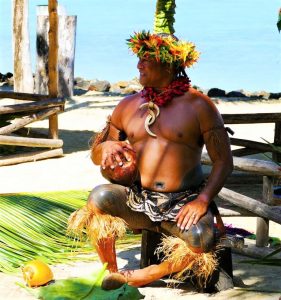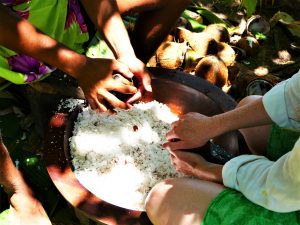LOVE MY COCONUTS (A local legend) SINA AND THE EEL
On the island of Savaii, in Samoa, is a village called Matavai, Safune. A local legend weaves an enchanting tale of an extraordinary love that blossomed the start of Love my coconuts.
Sina was a young girl whose beauty was renowned across the Pacific region. Word of her beauty reached the ears of the King of Fiji (Tui Fiti). Curious to see the maiden for himself, the King used his magic powers (mana) to transform himself into an eel and began his ocean journey to Samoa. Once there, he made his way to the fresh spring pool in Matavai, Safune.
One day, Sina came to the spring pool to bathe. The king looked up at her in awe.
“They have not lied. Every word that I have heard about this remarkable young lady is true.”
Sina’s glowing youthfulness melted his heart. However, when Sina looked into the water and saw the eel looking up at her she snapped. “Why are you staring at me with your demon-like eyes?” she angrily exclaimed. (“E pupula mai, ou mata ole alelo?”)
Through the passage of time and getting to know each other, Sina had a change of heart. With every visit to the village pool she noticed that the eel was gentle and kind, and it soon became her favorite pet. Their unique all be it an unusual bond grew and lasted for many years.
Not only for Sina, yet also many generations thereafter continue to experience the feeling of love they had for each other through the love of coconuts.
Now, the eel (Tui Fiti) was much older than Sina and as time passed he grew weaker, as did his magical powers.. He knew that the time had come to tell his friend the truth and so he did.
Sina learned that her pet eel was once the King of Fiji but because of his love for her, the King had chosen to remain in Samoa as an eel in order to be close to her. Tui Fiti gave Sina specific instructions that were to be carried out after his death, “Sina, I want you to forever love my coconuts”. When the time came she honored her dear friend’s wishes by burying his head in the ground. In that place a coconut tree grew. Eventually it produced nuts. When a coconut is husked it reveals a fibrous hard nut that has three round markings. Some say it looks like the face of a fish, others say it’s as if the coconut has two eyes and a mouth. Only one spot on the nut is soft enough to be pierced. It is from here that the sweet coconut juice can be drunk. The legend says that every time Sina drank juice from the coconut she kissed her king.
Today, the Mata o le Aleleo spring pool (which was named after the words that Sina spoke to the eel), in Matavai, Safune village is visited by tourists and locals, alike.
The tale of ‘Sina and The Eel’ has been retold and enjoyed for generations.
Although Sina held traditional values she was also an enterprising young lady. She learned to value relationships, trust her judgement and make the most of opportunities that presented itself. The coconut palm became a cherished symbol of an honored friend. It gave her many avenues to be creative and resourceful.
She gathers the Coconut Leaves for cooking and for storage.
She uses the Coconut Tree Trunk for shelter, supplies and furniture.
She indulges in the Niu from the coconut as the perfect form of hydration.
She uses the Coconut Shell as a source for creating peculiar pieces of the finest traditional jewelry.
This is her livelihood – her culture – her very source of life itself.
Coconuts are globally known for their versatility, ranging from food commodities & shelter, to cosmetics and income.
Love my coconuts, for they are the most useful of all plants and is the most predominantly grown crop right here in Samoa. For generations, throughout Polynesia and other regions of the world, the entire coconut palm tree has been used to sustain and enhance life in various ways. It is truly one of nature’s most symbolic illustration of enduring love. Coconut water and the white flesh of the nut is delicious and nutritious. The coconut flesh also produces a rich cream that is used in many cooking recipes and beauty regimes. With a simple process coconut oil can be extracted from the flesh and this is widely used to promote general health and head to toe body care. The hard shell of the coconut can be used as bowls for food or as drinking vessels. When polished and carved the shell makes beautiful jewelry, combs and cooking utensils.
The leaves can be plaited to make baskets that are both decorative and useful for storing food, utensils, clothing and other household items. They are used to provide shelter, to build homes and walls, to cover dirt floors and provide bedding. The leaves are also woven into hats and mats, purses, ornaments, decorations and footwear. Creative ideas surrounding the coconut palm seem endless and are constantly evolving.
The thin spine of the leaves are stripped and bound together to make brooms (salus) for sweeping both inside and outside the home.
Another reason I love my coconuts they come from the palm tree which is strong and durable. It’s timber is used to build boats, buildings, to make furniture and musical instruments.
The roots of the coconut palm used to make dyes, ornaments, door mats and even mouth rinses.
Its traditional value and multipurpose uses make it extremely important in the everyday lives of Samoans as an important source of food and income.
So needless to say, through the Eel’s gift of love, here in the islands we are incredibly blessed with such a Eco-friendly way of life, and the convenience that it is for each and every one of us that live here in the beautiful islands, that we continue to benefit from and feel the tenderness, warmth and devotion of the King of Fiji ( Tui Fiti) “the Eel”… Coconuts for life… Love my coconuts!


